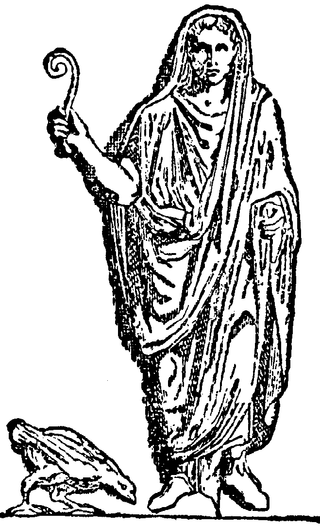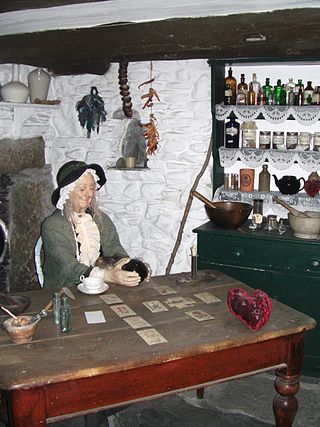Related Research Articles

Divination is the attempt to gain insight into a question or situation by way of an occultic ritual or practice. Using various methods throughout history, diviners ascertain their interpretations of how a querent should proceed by reading signs, events, or omens, or through alleged contact or interaction with supernatural agencies such as spirits, gods, god-like-beings or the "will of the universe".

Fortune telling is the unproven spiritual practice of predicting information about a person's life. The scope of fortune telling is in principle identical with the practice of divination. The difference is that divination is the term used for predictions considered part of a religious ritual, invoking deities or spirits, while the term fortune telling implies a less serious or formal setting, even one of popular culture, where belief in occult workings behind the prediction is less prominent than the concept of suggestion, spiritual or practical advisory or affirmation.

Geomancy translates literally to "earth divination," and the term was originally used to mean methods of divination that interpret geographic features, markings on the ground, or the patterns formed by soil, rocks, or sand. Its definition has expanded over time, to include any spiritual, metaphysical, or pseudoscientific practice that is related to the Earth. In recent times the term has been applied to a wide range of other occult and fringe activities, including Earth mysteries and the introduction of ley lines and Bau-Biologie.

Vicia faba, commonly known as the broad bean, fava bean, or faba bean, is a species of vetch, a flowering plant in the pea and bean family Fabaceae. It is widely cultivated as a crop for human consumption, and also as a cover crop. Varieties with smaller, harder seeds that are fed to horses or other animals are called field bean, tic bean or tick bean. Horse bean, Vicia faba var. equinaPers., is a variety recognized as an accepted name. This legume is very common in Southern European, Northern European, East Asian, Latin American and North African cuisines.

Alomancy, also called adromancy, ydromancie, idromancie, and halomancy, is an ancient form of divination. Similar to many other forms of divination, the diviner casts salt crystals into the air and interprets the patterns as it falls to the ground or travels through the air. The diviner can also interpret patterns that are formed from the residue of a salt solution as it evaporates in the bowl. The exact interpretations are unknown, but it probably follows a similar method to aleuromancy.

Augury was a Greco-Roman religion practice of observing the behavior of birds, to receive omens. When the individual, known as the augur, read these signs, it was referred to as "taking the auspices". "Auspices" means "looking at birds". Auspex, another word for augur, can be translated to "one who looks at birds". Depending upon the birds, the auspices from the gods could be favorable or unfavorable. Sometimes politically motivated augurs would fabricate unfavorable auspices in order to delay certain state functions, such as elections. Pliny the Elder attributes the invention of auspicy to Tiresias the seer of Thebes.

Phaseolus vulgaris, the common bean, is a herbaceous annual plant grown worldwide for its edible dry seeds or green, unripe pods. Its leaf is also occasionally used as a vegetable and the straw as fodder. Its botanical classification, along with other Phaseolus species, is as a member of the legume family Fabaceae. Like most members of this family, common beans acquire the nitrogen they require through an association with rhizobia, which are nitrogen-fixing bacteria.
Cleromancy is a form of sortition in which an outcome is determined by means that normally would be considered random, such as the rolling of dice (astragalomancy), but that are sometimes believed to reveal the will of a deity.

Scrying, also referred to as "seeing" or "peeping," is a practice rooted in divination and fortune-telling. It involves gazing into a medium, hoping to receive significant messages or visions that could offer personal guidance, prophecy, revelation, or inspiration. The practice lacks a definitive distinction from other forms of clairvoyance or divination but generally relies on visions within the chosen medium. Unlike augury, which interprets observable events, or divination, which follows standardized rituals, scrying's impressions arise within the medium itself.

Spodomancy is a form of divination by examining cinders, soot, or ashes, particularly although not exclusively from a ritual sacrifice. Spodomancy has been practiced by numerous cultures, ancient and modern, across the globe. While many practitioners have performed the ritual as part of a formal system of paranormal, religious, or ceremonial magic, many have done so as part of mere folkloric practice or superstition.
Cowrie-shell divination refers to several distinct forms of divination using cowrie shells that are part of the rituals and religious beliefs of certain religions. Though best-documented in West Africa as well as in Afro-American religions, such as Santería, Candomblé, and Umbanda, cowrie-shell divination has also been recorded in India, East Africa, and other regions.

Alectryomancy is a form of divination in which the diviner observes a bird, several birds, or most preferably a white rooster or cockerel pecking at grain that the diviner has scattered on the ground. It was the responsibility of the pullularius to feed and keep the birds used. The observer may place grain in the shape of letters and thus discern a divinatory revelation by noting which letters the birds peck at, or the diviner may just interpret the pattern left by the birds' pecking in randomly scattered grain.

The Ubykh are one of the twelve major Circassian tribes, represented by one of the twelve stars on the green-and-gold Circassian flag. Along with the Natukhai and Shapsug tribes, the Ubykh were one of three coastal Circassian tribes to form the Circassian Assembly in 1860. Historically, they spoke a distinct Ubykh language, which never existed in written form and went extinct in 1992 when Tevfik Esenç, the last speaker, died.

I Ching divination is a form of cleromancy applied to the I Ching. The text of the I Ching consists of sixty-four hexagrams: six-line figures of yin (broken) or yang (solid) lines, and commentaries on them. There are two main methods of building up the lines of the hexagram, using either 50 yarrow stalks or three coins. Some of the lines may be designated "old" lines, in which case the lines are subsequently changed to create a second hexagram. The text relating to the hexagram(s) and old lines is studied, and the meanings derived from such study can be interpreted as an oracle.

Tasseography is a divination or fortune-telling method that interprets patterns in tea leaves, coffee grounds, or wine sediments.

Knucklebones, also known as scatter jacks, snobs, astragaloi, tali, dibs, fivestones, jacks, jackstones, or jinks, among many other names, is a game of dexterity played with a number of small objects that are thrown up, caught, and manipulated in various manners. It is ancient in origin and is found in various cultures worldwide.

Molybdomancy is a technique of divination using molten metal. Typically, molten lead or tin is dropped into water. It can be found as a tradition in various cultures, including Austria, Bosnia and Herzegovina, Bulgaria, Germany, Finland, Estonia, Latvia, Switzerland, the Czech Republic, and Turkey. Some versions have been found to have potentially harmful effects on human health.

Witch, from the Old English wiċċe, is a term rooted in European folklore and superstition for a practitioner of witchcraft, magic or sorcery. Traditionally associated with malevolent magic, with those accused of witchcraft being the target of witch-hunts, in the modern era the term has taken on different meanings. In literature, a 'witch' can now simply refer to an alluring women capable of 'bewitching' others. In neopagan religions such as Wicca the term has meanwhile been adopted as the female term for an adherent.
Kumalak is a form of geomancy, or divination, which originates in Central Asia. This fortune telling method involves 41 beans, stones, or sheep dung sorted into piles, and has been used for hundreds of years in the region of present-day Kazakhstan, Kyrgyzstan, Mongolia, and Siberia by Turkic peoples such as the Kazakh, Kyrgyz, and Tatars.

Cunning folk, also known as folk healers or wise folk, were practitioners of folk medicine, helpful folk magic and divination in Europe from the Middle Ages until the 20th century. Their practices were known as the cunning craft. Their services also included thwarting witchcraft. Although some cunning folk were denounced as witches themselves, they made up a minority of those accused, and the common people generally made a distinction between the two. The name 'cunning folk' originally referred to folk-healers and magic-workers in Britain, but the name is now applied as an umbrella term for similar people in other parts of Europe.
References
- ↑ Tsapina, O. 2002 Something Old, Something New: Continuity and Modernization in Eighteenth-Century Russia. Available from JHU.
- ↑ Vogt, H. 1963 Dictionnaire de la langue oubykh page 149. Universitetsforlaget: Oslo.
- ↑ "Fortune telling". Falanje.com. Archived from the original on 2013-03-05. Retrieved 2013-04-11.
- ↑ Faith Wigzell (28 May 1998). Reading Russian Fortunes: Print Culture, Gender and Divination in Russia from 1765. Cambridge University Press. p. 43. ISBN 9780521581233.
- ↑ William Francis Ryan (January 1999). The Bathhouse at Midnight: An Historical Survey of Magic and Divination in Russia. Penn State Press. p. 113. ISBN 0271019670.